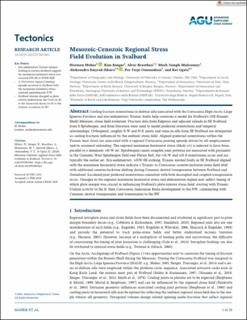| dc.contributor.author | Maher, Harmon | |
| dc.contributor.author | Senger, Kim | |
| dc.contributor.author | Braathen, Alvar | |
| dc.contributor.author | Mulrooney, Mark Joseph | |
| dc.contributor.author | Smyrak-Sikora, Aleksandra | |
| dc.contributor.author | Osmundsen, Per Terje | |
| dc.contributor.author | Ogata, Kei | |
| dc.date.accessioned | 2021-02-19T07:26:35Z | |
| dc.date.available | 2021-02-19T07:26:35Z | |
| dc.date.created | 2020-10-01T12:48:27Z | |
| dc.date.issued | 2020 | |
| dc.identifier.citation | Tectonics. 2020, 39 (4), . | en_US |
| dc.identifier.issn | 0278-7407 | |
| dc.identifier.uri | https://hdl.handle.net/11250/2729060 | |
| dc.description.abstract | Cooling fracture orientations in diabase sills associated with the Cretaceous High Arctic Large Igneous Province and syn‐sedimentary Triassic faults help constrain a model for Svalbard's (NE Barents Shelf) Mesozoic stress field evolution. Fracture data from Edgeøya and adjacent islands in SE Svalbard, from S Spitsbergen, and from literature were used to model preferred orientations and temporal relationships. Orthogonal, roughly E‐W and N‐S, joints and veins in sills from SE Svalbard are interpreted as cooling fractures influenced by the ambient stress field. Aligned preferred orientations within the Triassic host strata are associated with a regional Cretaceous jointing episode driven by sill emplacement and/or erosional unloading. The regional maximum horizontal stress (likely σ1) is inferred to have been parallel to a dominant ≈E‐W set. Spitsbergen's more complex joint patterns are associated with proximity to the Cenozoic West Spitsbergen Fold‐and‐Thrust Belt, but ≈E‐W and ≈N‐S orientations occur and are typically the earlier set. Syn‐sedimentary, ≈NW‐SE striking, Triassic normal faults in SE Svalbard aligned with the maximum horizontal stress indicate a Triassic to Cretaceous counterclockwise stress field shift, with additional counterclockwise shifting during Cenozoic dextral transpression between Svalbard and Greenland. Localized joint preferred orientations consistent with both decoupled and coupled transpression occur. Changes in the regional maximum horizontal stress and deformation regime may reflect timing of which plate margin was crucial in influencing Svalbard's plate interior stress field, starting with Triassic Uralian activity to the E, then Cretaceous Amerasian Basin development to the NW, culminating with Cenozoic dextral transpression and transtension to the SW. | en_US |
| dc.language.iso | eng | en_US |
| dc.publisher | American Geophysical Union | en_US |
| dc.title | Mesozoic-Cenozoic regional stress field evolution in Svalbard | en_US |
| dc.type | Peer reviewed | en_US |
| dc.type | Journal article | en_US |
| dc.description.version | publishedVersion | en_US |
| dc.source.pagenumber | 28 | en_US |
| dc.source.volume | 39 | en_US |
| dc.source.journal | Tectonics | en_US |
| dc.source.issue | 4 | en_US |
| dc.identifier.doi | 10.1029/2018TC005461 | |
| dc.identifier.cristin | 1836153 | |
| dc.relation.project | Norges forskningsråd: 295208 | en_US |
| dc.description.localcode | ©2020. American Geophysical Union. All Rights Reserved. | en_US |
| cristin.ispublished | true | |
| cristin.fulltext | preprint | |
| cristin.qualitycode | 2 | |
